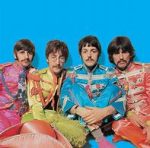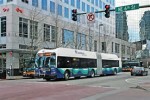
The drive was the part that made me nervous. I was in a rental car somewhere in Flathead Valley in the western portion of Montana, and just my luck, had chosen a bad day to make the journey from Whitefish to my ultimate destination, Glacier National Park. It was around 30 miles, and while it’s not that great a distance – I had literally made longer drives from Snohomish County to Kent for Christmas parties – I was still driving through unfamiliar territory in a relatively rural area. Fortunately for me, though, the freeway was free of traffic to a point that was shocking. The speed limit was a breezy 70 MPH, and the route from Whitefish to the closest entry point of Glacier Park was “make a left onto the freeway and drive straight until you’re there.” When I made my first visit to California in 2016 to get to my sister’s wedding, I got lost three times on the way from Oakland-Alameda Airport to the village in Sonoma County where the festival was taking place. That drive had been around 50 miles, and I never forgot that it had taken me about six hours after I plucked the overly complicated directions from Mapquest. By comparison, despite the distance, I was on the road from Whitefish to Glacier Park for under a half hour.
If I had known beforehand that a visit to Glacier was 35 dollars for a pass that ran for a whole week, I would have planned my trip there differently. Especially since I decided to make this visit during the offseason and the park was relatively free of tourists. I was able to walk around very easily, and while the roads were a bit more of a hassle, the traffic never proved to be even remotely a problem either. The people I encountered at Glacier had more of a small-town rapport with me – we were able to greet each other and talk to each other and advise each other on the roads and trails with minimal awkwardness. Being there during the offseason also treated me to some interesting sights I otherwise never would have thought about, like the number of small piles of forest debris being burned in controlled fires in the name of park maintenance. Walking to and from the village at the shore of Lake McDonald, I had a quick conversation with one of the rangers there and asked him about it. He told me that if a real forest fire started, having too much debris on the ground meant it could burn out of control quickly.
Visiting during the off months also meant that it was going to be hard to find professional help if I needed it. The first place I dropped into was a visitor center on account of wanting to double-check my tracks. The place was closed. So I hit one of the paved trails and walked to the end and into Apgar Village, one of the park camping villages. While the village wasn’t entirely closed, it also wasn’t up in full swing – the places that were open offered the important supplies, snacks, and souvenirs, but that was it. And unless I was willing to pay more for some trail mix than I really wanted to, I was definitely going to be skipping lunch that day. Strolling through the village, though, put me at the edge of Lake McDonald, one of the most incredible natural sites I’ve ever seen in my life. Lake McDonald is one of the lakes left from the old glaciers which were formed in midwestern Canada and the northern mountain states during the last Ice Age; it was created by the same ice that formed the Great Lakes. Although Apgar Village was sunny at the edge where I was standing, the far end of the lake was drenched in a cloud cover which made the mountains glow a mysterious shade of blue.
After seeing all I could see in Apgar Village, I walked back down the paved trail, through the forest and maintenance fires back to my rental car. Not satisfied yet, I turned onto the park’s famous Going-Into-the-Sun Road. And just my luck, the park had chosen to renovate the road right when I happened to be visiting. The renovation area also happened to be the part along the edge of Lake McDonald, which spanned nine miles and went for a significant stretch of where I had to drive. For the first few miles of the drive, everything was normal, save the occasional shower. Unfortunately, the construction crew soon showed up, and it slowed everyone down. When the park posted its notice about road work going on, what it didn’t mention was that the work in question was removing the asphalt, leaving me with a five-mile stretch of dirt to drive on. Even after the dirt road ended and I was back on asphalt, most of the observation and photography points were filled with construction vehicles and equipment. That also meant they had yellow tape, and I was deprived of some nice picture opportunities for a couple more miles.
Since the road was over 50 miles long, I knew I wouldn’t be driving the full length of it. But after the road work section finally stopped and I managed to stop at a few picture points for photos, I realized I was going to have to find a good point to turn back. I also realized I would need to find a decent place to stop, get out, and touch grass for an extended period of time. So when I saw a sign marking something called an Avalanche Lake campground, I put two and two together and figured that if there’s a campground in the area, it can’t be far from a decent hiking trail. After driving for another mile or two, I found a small parking lot lining the road, found a spot, and hopped out of the car. My logic proved to be right – there was a trail right at the edge of the parking lot, The Trail of the Cedars, and I set off on the small wooden walkway that took me through the forest.
The Trail of the Cedars wasn’t exactly the most challenging hike I’ve ever been on. I’m not an experienced hiker, but my sister and brother-in-law take me on Thanksgiving hikes whenever I’m in their town for the holiday, so I wasn’t going into it completely blind. But The Trail of the Cedars was pretty rudimentary even by my own low standards. It was something my sis and law-bro would laugh at if they were in the know. It was there partly as a trail and partly as a gateway to other, better trails – one of which was the Avalanche Lake Trail. When I saw a sign saying the trail to Avalanche Lake Trail was along THIS route, I took the detour in the hopes of finding something a bit longer and more complex. What I got was a trail with a complex topography, a brutal terrain, and a scenic route along a creek leading to Avalanche Lake which took me over a lot of slippery rocks. THIS was a trail that kicked the everloving shit out of me. It was supposed to be a little over two miles long, but it felt a lot longer. After a couple of miles (or what definitely FELT like miles; I had been on the trail for around an hour) I started to question whether it was the smartest thing to keep going. While the physicality made it more difficult than I had anticipated, it wasn’t the difficulty that started getting to me. I was sweating bullets on a chilly day. I had already removed my outdoor hat, and my back was doing that thing where it was alternating between being too hot to keep my fleece on and too cold when the wind got under me. The weather was also alternating between warm sun and cold rain, complete with dangerous-looking clouds constantly hanging over me. It had been raining on and off, and when it rained, I wasn’t buried in rain gear. It hit me somewhere along the line that if the torrential downpour that was threatening ever actually started, I was nowhere near the car and, not being prepared for such a weather event, probably risked freezing. So at some point, I accepted my loss and turned back.
All things considered, I had seen a sizable chunk of the park, despite not getting to any areas with actual glaciers. I didn’t feel like I was cheated or gypped. It did suck that my choice of season left me out of a lot of the major services, but it’s a national park. National parks are about seeing nature in its most pristine form, breathing the freshest air, and seeing land protected to stay in its natural condition. The rest of my visit to Montana was also very nice – Whitefish was a small and very walker-friendly village, Whitefish Lake was lovely, and the food and beer were excellent all around. But it was Glacier National Park that was the jewel, the centerpiece of the journey, and the piece that left the biggest impression.







